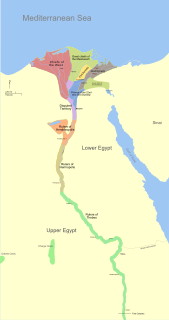
Thebes is a city in Boeotia, central Greece. It played an important role in Greek myths, as the site of the stories of Cadmus, Oedipus, Dionysus, Heracles and others. Archaeological excavations in and around Thebes have revealed a Mycenaean settlement and clay tablets written in the Linear B script, indicating the importance of the site in the Bronze Age.

Thebes, known to the ancient Egyptians as Waset, was an ancient Egyptian city located along the Nile about 800 kilometers (500 mi) south of the Mediterranean. Its ruins lie within the modern Egyptian city of Luxor. Thebes was the main city of the fourth Upper Egyptian nome and was the capital of Egypt for long periods during the Middle Kingdom and New Kingdom eras. It was close to Nubia and the Eastern Desert, with its valuable mineral resources and trade routes. It was a cult center and the most venerated city during many periods of ancient Egyptian history. The site of Thebes includes areas on both the eastern bank of the Nile, where the temples of Karnak and Luxor stand and where the city proper was situated; and the western bank, where a necropolis of large private and royal cemeteries and funerary complexes can be found.

Cilicia is a geo-cultural region in southern Anatolia (Turkey), extending inland from the northeastern coasts of the Mediterranean Sea. Cilicia has a population of over six million, concentrated mostly at the Cilicia plain. The region includes the provinces of Mersin, Adana, Osmaniye, and Hatay.

The Karnak Temple Complex, commonly known as Karnak, comprises a vast mix of decayed temples, chapels, pylons, and other buildings near Luxor, in Egypt. Construction at the complex began during the reign of Senusret I in the Middle Kingdom and continued into the Ptolemaic period, although most of the extant buildings date from the New Kingdom. The area around Karnak was the ancient Egyptian Ipet-isut and the main place of worship of the Eighteenth Dynasty Theban Triad with the god Amun as its head. It is part of the monumental city of Thebes. The Karnak complex gives its name to the nearby, and partly surrounded, modern village of El-Karnak, 2.5 kilometres north of Luxor.

Luxor is a city in Upper (southern) Egypt and the capital of Luxor Governorate. The population of Luxor is 127,994 (2020), with an area of approximately 417 square kilometres (161 sq mi). It is among the oldest inhabited cities in the world.

Tanis is the Greek name for ancient Egyptian ḏꜥn.t, an important archaeological site in the north-eastern Nile Delta of Egypt, and the location of a city of the same name. It is located on the Tanitic branch of the Nile, which has long since silted up. The first study of Tanis dates to 1798 during Napoléon Bonaparte's expedition to Egypt. Engineer Pierre Jacotin drew up a map of the site in the Description de l'Égypte. It was first excavated in 1825 by Jean-Jacques Rifaud, who discovered the two pink granite sphinxes now in the Musée du Louvre, and then by François Auguste Ferdinand Mariette between 1860 and 1864, and subsequently by William Matthew Flinders Petrie from 1883 to 1886. The work was taken over by Pierre Montet from 1929 to 1956, who discovered the royal necropolis dating to the Third Intermediate Period in 1939. The Mission française des fouilles de Tanis (MFFT) has been studying the site since 1965 under the direction of Jean Yoyotte and Philippe Brissaud, and François Leclère since 2013.
Ptolemy is a name derived from Ancient Greek. Common variants include Ptolemaeus (Latin), Tolomeo (Italian) and Talmai (Hebrew).

Tantamani, also known as Tanutamun or Tanwetamani was a pharaoh of Ancient Egypt and the Kingdom of Kush located in Northern Sudan and a member of the Twenty-fifth Dynasty of Egypt. His prenomen or royal name was Bakare, which means "Glorious is the Soul of Re."

The Third Intermediate Period of ancient Egypt began with the death of Pharaoh Ramesses XI in 1070 BC, which ended the New Kingdom, and was eventually followed by the Late Period. Various points are offered as the beginning for the latter era, though it is most often regarded as dating from the foundation of the Twenty-Sixth Dynasty by Psamtik I in 664 BC, following the departure of the Nubian Kushite rulers of the Twenty-fifth Dynasty by the Assyrians under King Assurbanipal. The concept of a "Third Intermediate Period" was coined in 1978 by British Egyptologist Kenneth Kitchen.
Olbia is a city in Sardinia, Italy.
Nicopolis was an Ancient city and archbishopric in Epirus, now in continental Greece.
Philadelphia is the largest city in the U.S. state of Pennsylvania.
Amun was a major ancient Egyptian deity who appears as a member of the Hermopolitan Ogdoad. Amun was attested from the Old Kingdom together with his wife Amaunet. With the 11th Dynasty, Amun rose to the position of patron deity of Thebes by replacing Montu.
Phthiotic Thebes or Thessalian Thebes was a city and polis in ancient Thessaly, Greece; its site north of the modern village of Mikrothivai.

Aphrodisias, sometimes called Aphrodisias of Cilicia to distinguish it from the town of the same name in Caria, was a port city of ancient Cilicia whose ruins now lie near Cape Tisan in Mersin Province, Turkey.
The Metropolis of Thebes and Livadeia is a metropolitan see of the Church of Greece in Boeotia, Greece. Since the Middle Ages it has also existed as a Roman Catholic titular see. The current metropolitan is Georgios Mantzouranis.

The Thirty-first Dynasty of Egypt, also known as the Second Egyptian Satrapy, was effectively a satrapy of the Achaemenid Persian Empire between 343 BC to 332 BC. It was founded by Artaxerxes III, the King of Persia, after his reconquest of Egypt and subsequent crowning as Pharaoh of Egypt, and was disestablished upon the conquest of Egypt by Alexander the Great.
Thebes or Thebae or Thebai was a port town of ancient Ionia, under the Mycale mountains.









